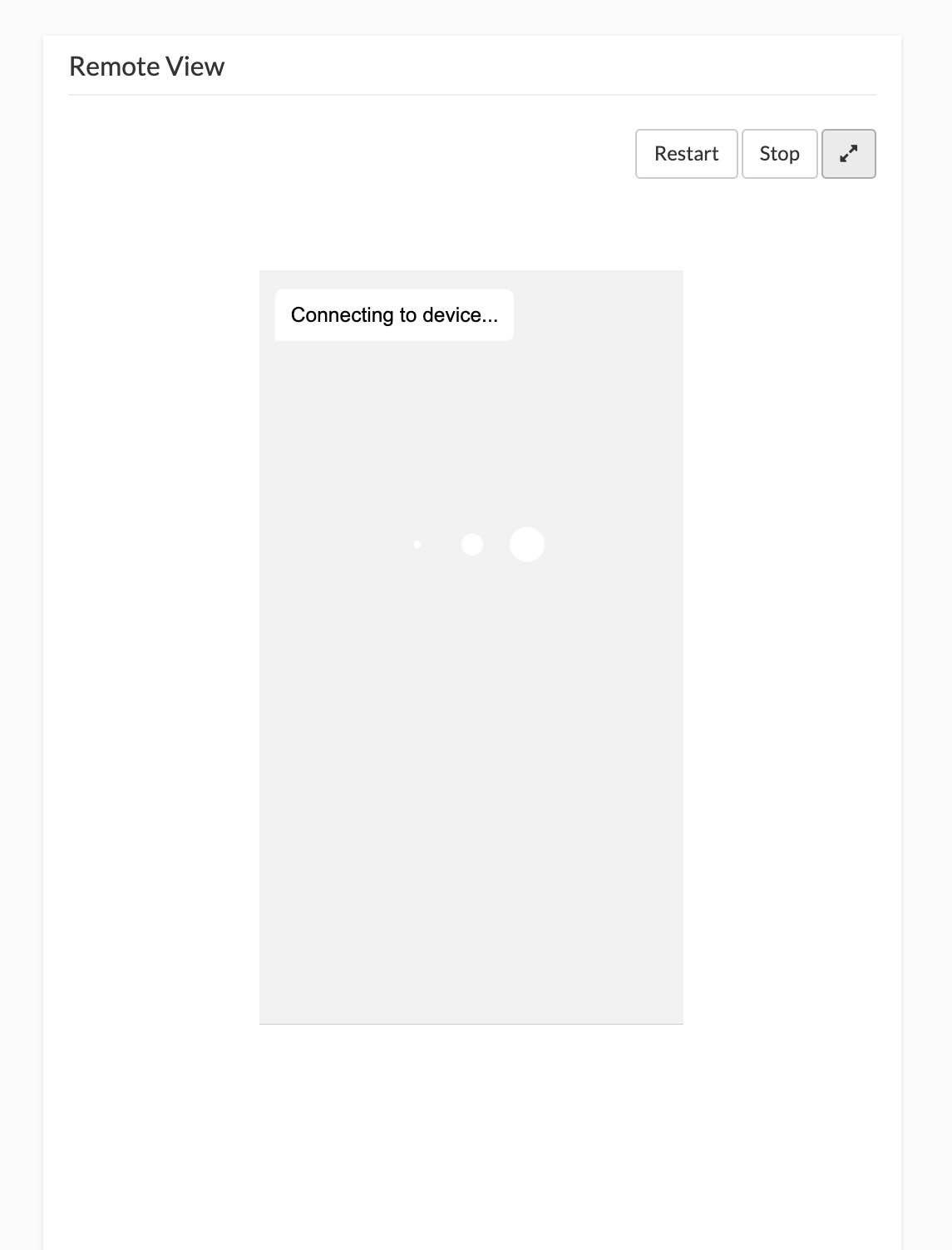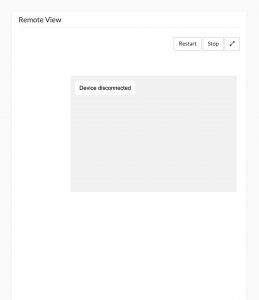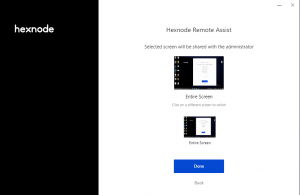Category filter
How to fix Remote View issues on Windows
1. “Connecting to device…” keeps showing on the Remote View window

Cause
The Hexnode Remote Assist app on the endpoint device is used for initiating a remote view session on the endpoint device. For the app to start a session, it will ask for end-user consent. The ‘Connecting to device’ status is shown on the portal while the consent request is sent to the device.
You might be seeing this status for an extended time when –
- The user has not granted remote viewing permission to the Hexnode Remote Assist app.
- The device is not reachable.
Solution
- Check your firewall settings to ensure the required port (443) is open for initiating the session.
- Ensure the device is up and running and the user has access to this device to grant permission.
- Ensure the user has granted permission to the Hexnode Remote Assist app.
2. Remote view session is terminated with “Device disconnected” status

Cause
Certain events on the device end can end up terminating the remote view session undesirably. Some probable cases are –
- The device was put in Restart/Shut Down/Sleep.
- The user was logged out.
- User revoked permission on Hexnode Remote Assist app.
- The Remote Assist app process was disrupted (for example: from the Task Manager).
- The device was disconnected from the network.
Solution
- Ensure the device is online.
- Restart the remote view session and grant permission.
3. Only the ‘Entire Screen’ option is shown on the Hexnode Remote Assist app for screen selection

The Hexnode Remote Assist app supports the sharing of external displays connected to the same device. You may share the ‘screen’ of any one of these displays by opening the Hexnode Remote Assist app and selecting Grant Permission > Select Screen > [Select your screen] > Done.
If you have not connected to any external display, Hexnode Remote Assist will show only one screen in the option. The option is not to share or switch between multiple desktop spaces on the Mac, the Remote View will stream the active space on display by default.
4. It shows Grant permission on the app, even after the session is started
Cause
This issue occurs when the user has multiple instances of the Hexnode Remote Assist app open. For example, while permission was granted on an active instance, the user opens another older app instance.
Solution
Exit the app showing the obsolete status. The next time you open the app, it should show the updated status.
5. The remote view screen is flickering
Cause
This issue occurs when external displays are connected to the device, and the shared display becomes inactive.
Solution
Move the cursor to the inactive screen or perform some action on the inactive screen to solve this issue. If the problem persists, restart the session.
6. App shows multiple icons on the taskbar
Multiple icons appear on the taskbar when the app is opened multiple times on the device, starting multiple app instances. It will get fixed when the user clicks on Show hidden icon from the taskbar. The other inactive instances will be automatically closed, and the system will maintain only one active app instance.
7. Unable to initiate remote view session while in kiosk mode
Cause
Remote viewing is not possible on single app kiosk mode. If a remote view session is initiated when the device is in single app kiosk mode, the remote view window in the portal keeps loading endlessly. Remote Viewing is supported only on multi app kiosk mode.
Solution
Though the Remote View is supported on multi app kiosk, it is not possible to initiate a remote view session unless:
- The device has the latest versions of the Hexnode Agent app and Remote Assist app installed. (Hexnode Agent app gets installed by default once you enroll your device. However, the Remote Assist app should be manually installed from the Device Summary page of the device in the Hexnode UEM console).
- The Remote Assist app is added to the start layout and the Hexnode Agent app and Remote Assist app are added as desktop applications in the Multi App Kiosk Lockdown policy.
To initiate a remote view session in multi app kiosk mode, configure the Multi App Kiosk Lockdown policy & follow the steps as mentioned below.
Before configuring the policy in the Hexnode UEM console, there are some steps to be completed on the device end.
On the Windows device end,
- Create a local user account on your Windows device.
- Install the kiosk apps within the local account including the Hexnode Remote Assist app.
- Pin the Hexnode Remote Assist app to the Start menu layout. Also, add all the apps that you need in the kiosk mode to the Start menu layout.
- Once you have customized the Start menu layout, export it as a .xml file using Windows PowerShell.
On the Hexnode portal end,
- Navigate to the Policies tab > New Policy > Kiosk Lockdown > Windows Kiosk Lockdown.
- Select Multi App. Click Configure.
- Enter the Kiosk account (Local user account) name.
- Click on the + button to select the apps to be added in kiosk mode.
- Import the Start menu layout .xml file.
- In addition to adding the Hexnode Remote Assist app to the start menu layout, add it as a desktop application by mentioning (C:\Hexnode\Hexnode Remote Assist\Current\Hexnode Remote Assist.exe) as path and HexnodeRemoteAssist.exe as the App name.
- Hexnode Agent service is added as a desktop application in the policy by default. If it’s not added by default in the policy, add the Hexnode Agent app as a desktop application by mentioning (C:\Hexnode\Hexnode Agent\Current\HexnodeAgent.exe) as path & HexnodeAgent.exe as the App name.
- Ensure that the Hexnode Remote Assist app is added to the start menu layout (.xml file). Also, ensure that both the Hexnode Agent app & Hexnode Remote Assist app are added as desktop apps before saving the policy and associating it to the target device.
Once the policy is associated with the device, if a remote view session is initiated when the device is locked under multi app kiosk mode, the Hexnode Remote Assist app shows up as a minimized icon in the taskbar on the device. The user should manually open the Remote Assist app on the device end and grant permission to start the remote view session. Once permission is granted, you can remotely view the device from the console.
Other Issues
Please check if the issue persists after restarting the remote view session for any other case not listed here. If the problem endures, feel free to contact us for assistance.


